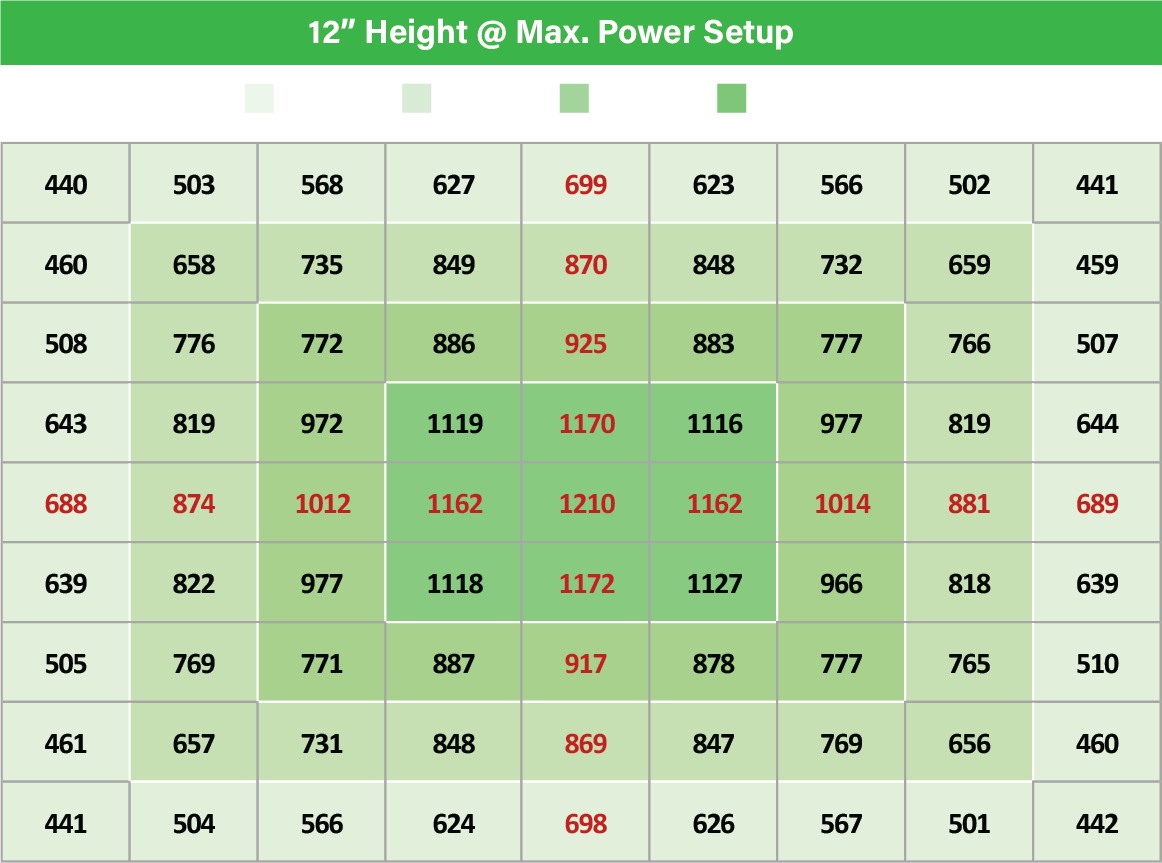Menu
Menu
$825.00
Our Ultra Slim Series represent the ideal LED grow lights designed for vertical growers. These lights feature a sleek, flat body with a high photon conversion rate and low heat emission, making them perfectly compatible with popular two-tier or three-layer grow racks from general rolling rack suppliers.
What’s in the box:
1x Ultra800 LED Grow light
1x Controller Splitter
1x Input Plugs
1x Dimming RJ-12 Data Cable
| PERFORMANCE DATA | MAX. POWER @ 12" HEIGHT |
| PPF | 2080 μmol/s |
| PPFD | 1210µmol/(m2*s) |
| PPE | 2.6 µmol/J |
RECOMMENDED SET-UP
FLOWER: 4'X4' AREA, 5'X5' AREA
VEG: 4'X4' AREA, MAX: 6'X6' AREA
SEPCIAL DISTRIBUTION

MAXIMUM POWER ELECTRICAL DATA
| AC VOLTAGE | 120V | 208V | 240V | 277V |
| AC CURRENT | 4.662A | 4.015A | 3.489A | 3.107A |
| AC POWER | 835.5W | 830.7W | 830.5W | 827W |
| POWER FACTOR | 0.99 | 0.99 | 0.99 | 0.98 |
PPFD READING

A 800W slim profile full-spectrum LED grow lighting solution designed for commercial indoor applications, enabling control over the plant cycle from the vegetative stage to the flowering stage. Indoor plants grow best under full-spectrum lights, which replicate the natural spectrum of the sun. The Ultra Series, with an increased lifespan over traditional grow light sources, cultivates healthier, happier plants.

Our Classic Series Grow Lighting, Ultra Series Grow Lighting and Beast Series Grow Lighting are fully compatible with the TrolMaster System, including the HYDRO-X SYSTEM, AQUA-X SYSTEM, TENT-X SYSTEM, and CARBON-X SYSTEM, with the use of the Adapter LMA-14. This seamless integration allows for a comprehensive control and monitoring solution, empowering growers to manage their indoor cultivation environments effortlessly.
The Classic Series, Ultra Slim Series and Beast Series are advanced full-spectrum LED matrix horticultural grow lights, meticulously designed to cater to the diverse needs of indoor growers. These lights offer customizable settings, allowing growers to adjust light intensity, spectrum, and duration according to specific plant requirements, resulting in improved crop yields and quality.
Designed to provide optimal lighting conditions for plant growth, the Classic Series, Ultra Slim Series and Beast Series, in conjunction with the TrolMaster System, offer an efficient and user-friendly solution for modern horticultural practices. With their adaptable features and precise control mechanisms, these lighting systems ensure that plants receive the ideal lighting conditions throughout their growth cycles, facilitating healthy and robust plant development.
Utility companies incentivize cultivators to embrace sustainability by offering rebates for approved LED grow lights. LEDs, renowned for their superior efficiency compared to traditional HID lights, consume less electricity while producing equivalent light output. This promotion underscores the commitment to energy-efficient solutions in indoor cultivation. Keep in mind that specific specifications and guidelines apply to the process of claiming these rebates, ensuring a seamless transition to eco-friendly lighting practices.
| WATTAGE | 800W |
|---|---|
| INPUT POWER | 208V-277V |
| CONTROLLER | TROLMASTER+LMA14 |
| CONTROL | 0-10V dimming (0-100%) |
| DAISY CHAIN PORT | RJ12 |
| MOUNTING HEIGHT | 36 INCHES ABOVE CANOPY |
| POWER FACTOR | >0.9 |
| THERMAL MANAGEMENT | Passive |
| WORKING TEMPERATURE | 0ºF ~ 104ºF |
| IP RATING | Waterproof IP65 |
|---|---|
| DIODE LIFETIME | L90: >36,000 hrs |
| DRIVER TIME | >50,000 hrs |
| WARRANTY | 5-year limited |
| CERTIFICATIONS | ETC, FCC, DLC |
| PERFOR MANCE DATA | 800W (100%) @ 12″H |
| PPF | 2080 μmol/s |
| PPE | 2.6 μmol/J |
There are no reviews yet.
All Rights Reserved by GrowPros Solutions
Only logged in customers who have purchased this product may leave a review.